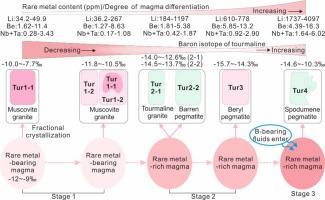Magma differentiation and rare metal mineralization of the Qongjiagang area, Himalayan orogen: evidence from trace element and boron isotope compositions of tourmaline
IF 3.6
2区 地球科学
Q1 GEOLOGY
引用次数: 0
Abstract
Strongly fractionated granitic-pegmatitic rocks of the Qongjiagang area, Himalayan orogen are associated with economically important rare metal (e.g., Li, Nb, Be, and Ta) mineralization. Tourmaline is a frequent mineral in both the granites and pegmatites, which makes it an ideal candidate for investigating magmatic to hydrothermal processes that led to the rare metal enrichment. However, a systematic investigation of the response patterns of tourmaline compositions to differentiation processes is still lacking. In this study, we present petrographic and characteristics of the granitic-pegmatitic rock suites, as well as the chemical and boron isotopic compositions of tourmaline. Tourmalines in all samples exhibit schorl characteristics. Those from part of the muscovite granites exhibit pronounced zoning with highest MgO contents and δ11B ratios being recorded by their cores (δ11B: −10.0 ∼ −7.74 ‰) whereas the rims trend to lower δ11B (−11.8 ∼ −10.5 ‰). The δ11B ratios of the tourmaline rims are close to those of unzoned tourmalines of the other muscovite granite samples (−12.5 ∼ −12.1 ‰). Tourmalines of tourmaline granite (−14.5 ∼ −13.9 ‰) and barren pegmatite (−14.0 ∼ −12.9 ‰) exhibit comparably low δ11B ratios. The ones in beryl pegmatites are characterized by the lowest δ11B ratios (−15.7 ∼ −14.3 ‰) but at the same time high concentrations of B2O5 and enrichment in Pb, Nb, Ta, and the light rare earth elements. Notably, tourmalines of spodumene pegmatites show variable δ11B ratios (−14.6 ∼ −10.3 ‰) and at the same time high values of Al2O3, B2O5, Li, Be, Sn, Cr, La, Ce, Pb, and Zn, yet low SiO2. The textural position, as well as element and B isotope composition of tourmaline suggest a magmatic origin of all tourmalines, and record the magma differentiation from early muscovite granite to the subsequently formed pegmatites, with tourmaline of the spodumene pegmatite being subsequently altered by hydrothermal fluids. The variable composition of the tourmalines records independent enrichment of different rare metals during differentiation. Following this, tourmaline is a useful tool to reconstruct rare metal enrichment and mineralization processes controlled by granite magma differentiation and during interaction with externally derived fluids at the magmatic–hydrothermal transition.

喜马拉雅造山带琼家岗地区岩浆分异与稀有金属成矿作用——来自电气石微量元素和硼同位素组成的证据
喜马拉雅造山带琼家岗地区强分异花岗伟晶岩与具有重要经济意义的稀有金属(如Li、Nb、Be、Ta)成矿有关。电气石是花岗岩和伟晶岩中常见的矿物,这使其成为研究导致稀有金属富集的岩浆-热液过程的理想候选者。然而,对于电气石成分对分化过程的响应模式,目前还缺乏系统的研究。在本研究中,我们介绍了花岗岩-伟晶岩组的岩石学和特征,以及电气石的化学和硼同位素组成。所有样品中的电气石均表现出校形特征。部分白云母花岗岩具有明显的分带性,岩心记录的MgO含量和δ11B比值最高(δ11B: - 10.0 ~ - 7.74‰),而岩缘则呈低δ11B趋势(- 11.8 ~ - 10.5‰)。电气石边缘的δ11B值与其他白云母花岗岩样品中电气石的δ11B值接近(−12.5 ~−12.1‰)。电气石花岗岩中的电气石(−14.5 ~−13.9‰)和秃晶岩中的电气石(−14.0 ~−12.9‰)δ11B比值相对较低。绿柱伟晶岩的δ11B比值最低(−15.7 ~−14.3‰),但B2O5浓度较高,富集Pb、Nb、Ta和轻稀土元素。锂辉石辉晶岩的电气石δ11B值变化较大(−14.6 ~−10.3‰),Al2O3、B2O5、Li、Be、Sn、Cr、La、Ce、Pb、Zn含量较高,SiO2含量较低。电气石的结构位置、元素和B同位素组成表明所有电气石均为岩浆成因,并记录了从早期白云母花岗岩到后来形成的伟晶岩的岩浆分异过程,其中辉石伟晶岩中的电气石随后受到热液的蚀变。电气石的变化组成记录了不同稀有金属在分异过程中的独立富集。因此,电气石是重建花岗岩岩浆分异控制和岩浆-热液转换过程中与外源流体相互作用过程中稀有金属富集和成矿过程的有用工具。
本文章由计算机程序翻译,如有差异,请以英文原文为准。
求助全文
约1分钟内获得全文
求助全文
来源期刊

Ore Geology Reviews
地学-地质学
CiteScore
6.50
自引率
27.30%
发文量
546
审稿时长
22.9 weeks
期刊介绍:
Ore Geology Reviews aims to familiarize all earth scientists with recent advances in a number of interconnected disciplines related to the study of, and search for, ore deposits. The reviews range from brief to longer contributions, but the journal preferentially publishes manuscripts that fill the niche between the commonly shorter journal articles and the comprehensive book coverages, and thus has a special appeal to many authors and readers.
 求助内容:
求助内容: 应助结果提醒方式:
应助结果提醒方式:


